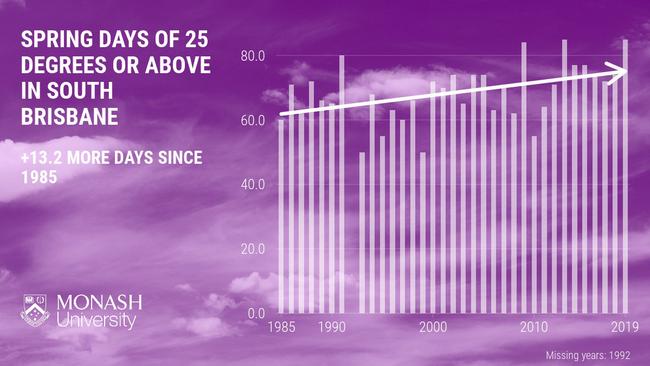The latest from the Weather Bureau: Locals can expect a warm weekend ahead with possible thunderstorms.
Weather Bureau latest: weekend forecast continues trend of warmer spring days. Plus, how are warmer ocean temperatures impacting one of Queensland's biggest tourist attractions?

HyperLocal
Don't miss out on the headlines from HyperLocal. Followed categories will be added to My News.
South Brisbane is set for a warm weekend ahead, hitting a top of 30 degrees, with scattered showers and a possible thunderstorm on Sunday.
Spring in south Brisbane is warmer than it was in 1985, with 13 extra days of the season hitting at least 25 degrees.
Last year, 85 out of 91 spring days were 25 degrees or warmer.
This warming trend can be seen across southeast Queensland with Amberley, Brisbane Airport, Cape Moreton and Logan all recording an increase in Spring temperatures reaching this threshold than they used to.
Voices from your community
Warming trends like these are not just occurring on land - we're also seeing an increase in ocean temperatures.
David Wachenfeld, chief scientist at the Great Barrier Reef Marine Park Authority explains why ocean warming can lead to coral bleaching.
"Corals are smaller than a centimetre across, but there are tens or hundreds of thousands of them in each colony," Dr Wachenfeld said.
"There are millions if not billions of colonies in the Great Barrier Reef and once you add all that up, this tiny little animal has made a structure that you can see from space."
Corals become stressed when ocean temperatures are too warm for too long.
Over the past five years Wachenfeld has observed three mass bleaching events triggered by above average ocean temperatures.
Otherwise known as 'marine heat waves,' when these events occur, coral expel the microscopic algae that live inside their tissues, leaving them 'bleached'.
"It's important to realise that bleaching is a stress response," Dr Wachenfeld said.
"If that stress isn't too great, at the end of the day the coral will recover, (but) if it's very great, the coral will die."
In the past 25 years, half of the coral found on Australia's Great Barrier Reef has disappeared.
Fast fact
Why is coral so colourful?
The microscopic algae that feed and live inside coral are what gives them their vibrant colours.
Some species also produce colourful protein pigments to protect against UV rays and adapt to different light and temperature conditions.
Healthy coral cover provides food and habitat for marine life and protects our coastlines for storms and erosion.
Dr Christa Pudmenzky is a climate scientist at the University of Southern Queensland.
This column is part of a collaboration between Monash University and News Corp to deliver hyperlocal weather and climate information.
Questions? You can email us at mcccrh@monash.edu
Community voices tell us how residents and business owners in south Brisbane feel about their local climate. If you would like to contribute your voice to our column, you can fill out our 5-minute survey here.
